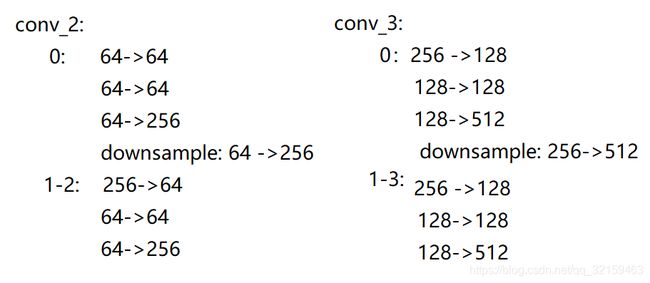pytorch实现resnet网络结构
ResNet结构和pytorch实现

resnet的网络结构都是经过5个不同数量的残差块+最后一个全连接分类完成的。
在resnet50以后,由于层数的增加残差块发生了变化,从原来3x3卷积变为三层卷积,卷积核分别为1x1、3x3、1x1,减少了网络参数。主要通过两种方式:1.用zero-padding去增加维度 2.用1x1卷积来增加维度

这是我之前做的读书笔记,忘记看的什么书了,就不加引用了,抱歉
from torch import nn
import torch as t
from torch.nn import functional as F
import cv2
class ResdiualBlock(nn.Module):
"""
实现子module:Residual Block
"""
def __init__(self, inchannel, outchannel, stride=1, shortcut=None):
super(ResdiualBlock, self).__init__()
self.left = nn.Sequential(
nn.Conv2d(inchannel, outchannel, 3, stride, 1, bias=False),
nn.BatchNorm2d(outchannel),
nn.ReLU(inplace=True),
nn.Conv2d(outchannel, outchannel, 3, 1, 1, bias=False),
nn.BatchNorm2d(outchannel)
)
self.right = shortcut
def forward(self, x):
out = self.left(x)
residual = x if self.right is None else self.right(x)
out += residual
return F.relu(out)
class ResNet(nn.Module):
"""
实现主Module:ResNet34
ResNet34包含多个layer, 每个layer又包含多个residual block
用子module实现residual block, 用_make_layer函数实现layer
"""
def __init__(self, num_classes=1000):
super(ResNet, self).__init__()
# 图像转换
self.pre = nn.Sequential(
# in_channel, out_channel, kernel_size, stride, padding
nn.Conv2d(3, 64, 7, 2, 3, bias=False, ),
nn.BatchNorm2d(64),
nn.ReLU(inplace=True),
nn.MaxPool2d(3, 2, 1)
)
# 重复的layer, 分别有3,4,6,3 个residual block
self.layer1 = self._make_layer(64, 128, 3)
self.layer2 = self._make_layer(128, 256, 4, stride=2)
self.layer3 = self._make_layer(256, 512, 6, stride=2)
self.layer4 = self._make_layer(512, 512, 3, stride=2)
# 全连接分类
self.fc = nn.Linear(512, num_classes)
def _make_layer(self, inchannel, outchannel, block_num, stride=1):
"""
构建residual block
"""
shortcut = nn.Sequential(
nn.Conv2d(inchannel, outchannel, 1, stride, bias=False),
nn.BatchNorm2d(outchannel)
)
layers = []
layers.append(ResdiualBlock(inchannel, outchannel, stride, shortcut))
for i in range(1, block_num):
layers.append(ResdiualBlock(outchannel, outchannel))
return nn.Sequential(*layers)
def forward(self, x):
x = self.pre(x)
x = self.layer1(x)
x = self.layer2(x)
x = self.layer3(x)
x = self.layer4(x)
x = F.avg_pool2d(x, 7)
x = x.view(x.size(0), -1)
return self.fc(x)
model = ResNet()
# input = t.autograd.Variable(t.randn(1,2,244,244))
# out = model(input)
print(model)
查看pytorch提供的resnet的网络结构
import torch
from torchvision import models
from torchsummary import summary
resnet = models.resnet101()
print(resnet)
summary(resnet, (3, 224, 224), device='cpu')
下面进行用pytorch实现resnet101网络,resnet50和152只是残差块数量不同,其他一致。
代码有点乱,望多多包含
import torch
from torchvision import models
from torchsummary import summary
from torch import nn
from torch.nn import functional as F
resnet = models.resnet101()
print(resnet)
summary(resnet, (3, 224, 224), device='cpu')
class ResNet101(nn.Module):
def __init__(self, in_channels, num_class):
super(ResNet101, self).__init__()
self.in_channels = in_channels
self.out_channels = num_class
self.pre = nn.Sequential(
nn.Conv2d(in_channels, 64, kernel_size=(7, 7), stride=2, padding=3),
nn.BatchNorm2d(64),
nn.ReLU(inplace=True),
nn.MaxPool2d(3, stride=2, padding=1)
)
self.conv2 = self._make_layer(64, 64, 3, stride=1)
self.conv3 = self._make_layer(256, 128, 4, stride=2)
self.conv4 = self._make_layer(512, 256, 23, stride=2)
self.conv5 = self._make_layer(1024, 512, 3, stride=2)
self.pool = nn.AvgPool2d(7, stride=1)
self.linear = nn.Linear(2048, num_class)
def _make_layer(self, in_channels, out_channels, block_num, stride=1, expansion=4):
layer = []
layer.append(Bottleneck(in_channels, out_channels, stride=stride, sample=True))
for i in range(1, block_num):
layer.append((Bottleneck(out_channels * expansion, out_channels)))
return nn.Sequential(*layer)
def forward(self, x):
x = self.pre(x)
x = self.conv2(x)
x = self.conv3(x)
x = self.conv4(x)
x = self.conv5(x)
print(x.size())
x = self.pool(x)
x = x.view(x.size(0), -1)
x = self.linear(x)
return x
class Bottleneck(nn.Module):
def __init__(self, in_channels, out_channels, stride=1, sample=False, expansion=4):
super(Bottleneck, self).__init__()
self.in_channels = in_channels
self.out_channels = out_channels
self.expansion = expansion
self.sample = sample
self.block = nn.Sequential(
nn.Conv2d(in_channels, out_channels, kernel_size=1,stride=1),
nn.BatchNorm2d(out_channels),
nn.ReLU(),
nn.Conv2d(out_channels, out_channels, kernel_size=3, stride=stride, padding=1),
nn.BatchNorm2d(out_channels),
nn.ReLU(),
nn.Conv2d(out_channels, out_channels * expansion, kernel_size=1, stride=1),
nn.BatchNorm2d(out_channels * expansion),
nn.ReLU()
)
if self.sample:
self.downsample = nn.Sequential(
nn.Conv2d(in_channels, out_channels * expansion, kernel_size=1, stride=stride),
nn.BatchNorm2d(out_channels * expansion)
)
def forward(self, x):
out = self.block(x)
print(out.size())
residual = self.downsample(x) if self.sample is not False else x
out += residual
return F.relu(out)
if __name__ == "__main__":
res = ResNet101(3, 10)
print(res)
input = torch.randn(1, 3, 224, 224)
out = res(input)
print(out.shape)
# summary(res, (3, 512, 512), device='cpu') #太占用内存
介绍我在实现过程中遇到的问题,期间参考的博客在下方提供链接。
问题1.在101_layer中conv2_x中最后一层256通道的1x1卷积在conv3_x怎么变成了128。
第二个问题是输出的feature map是通过设置卷积的stride来逐倍缩小的。
参考:
https://blog.csdn.net/shanglianlm/article/details/86376627
